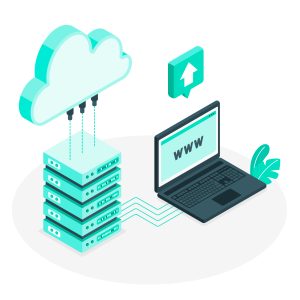While creating or building a website, the security of a website is supposed to be given the topmost priority. And with the announcement of Google giving priority to HTTPS, migrate your website from HTTP to HTTPS has become essential.
In this post, we will see a few differences between HTTP and HTTPS, the reasons for migrating, and what steps to follow.
HTTP vs HTTPS
HTTP stands for HyperText Transfer Protocol, it is utilized to communicate on the world wide web (www).
On the other hand, HTTPS is the secure version of HTTP. HTTPS stands for HyperTeXT Transfer Protocol Secure. With HTTPS the data sent across the communication channel established is secure. Hence, HTTPS is usually used on websites that deal with e-commerce transactions or banking.
Why migrate your website from HTTP to HTTPS?
Besides the three layers of protection given by HTTPS, there are various other reasons for migrating your website from HTTP to HTTPS. Now let us see those three key layers.
Enhanced SEO Ranking
Not only making your website secure helps in protecting website but also helps in ranking with Google’s secure web initiative
As per Google’s secure web initiative, Google promotes website security by
- Declaring HTTPS as a ranking signal
- High preference given to index HTTP pages
- Exposing myths regarding HTTPS and explaining how it is simple and cheap to shift to HTTPS
Additionally, you can read the article “Improve Website SEO with Cloudflare” to improve your website SEO.
Security
The security is offered by TLS (Transport Layer security) an is necessarily provided in three-layer namely:
- Encryption: Data is encrypted and no one except the end-user can decrypt it. Hence if there is a middle man present in between, he/she couldn’t steal the information.
- Data integrity: Data sent or received in the channel cannot be corrupted or altered without the detection.
- Authentication: Ability to communicate with the end-users without an attacker interrupting the conversation.
Better Performance
By the up-gradation of HTTP to HTTP 2.0, several browsers support the latest protocol over the protected HTTPS network. Migrating to HTTPS enhances the website speed and as a result, enhances the performance of website and user experience.
Meanwhile, you can also read this article A quick guide to Install Varnish on cPanel to boost your website performance
Steps to migrate
Obtaining a Valid SSL Certificate
To start with, you need an SSL certificate. SSL Certificate is a digitally signed certificate that authenticates the integrity of a website and use encryption to send data to the website. There are various kinds of SSL certificates however the most recommended one is an EV SSL Certificate. You can also opt for a COMODO SSL Certificate. ByteNap offers mainly 4 categories of SSL certificates.
- EV SSL
- COMODO
- WILDCARD
- POSITIVE
Installing an SSL Certificate
One of the most crucial things to remember is that you require an SSL certificate of Certificate Authority(CA) for installing an SSL certificate. The CA bundle consists of a root and intermediate certificates of the CA. On a successful certificate issued, it will be accessible in the control panel.
- Login to your Control Panel
- Go to the Order Information view
- To view data, click on view certificate details, a pop-up will display the certificate. For installing any SSL certificate on your server, it mainly depends on the software you are operating or running.
If you need to host several SSL certificates for various domains on the same IP address then you could install the through SNI(Server Name Identification). Installing SSL through an SNI doesn’t need a dedicated IP address
Update Hard-coded links to HTTPS
It is a great manner to utilize relevant URLs, however, there are possibilities someone has hard-coded a URL, in such a case you will be required to perform a complete cleansing of your website during the migration process.
If you are a WordPress user then you can simply follow Yoast’s instructions. You will also need to install the WordPress HTTPS plugin. Or else if you are a non-CMS user then you will require to look for all the links. This incorporates links to pages, JavaScript, CDN, images, and, anything that your website might utilize. The subsequent step is to modify the relevant link paths. For instance, if the link is “http://yourdomain.social/link” then it should be “/link”. Eventually, refresh your cache on both websites and browsers and verify the links.
Update custom JavaScript, AJAX libraries to HTTPS
In case you have installed any custom script on your website, you will need to modify it to HTML as well. For instance, if you are utilizing Google’s jQuery then you can redirect it to their HTTPS version https://ajax.googleapis.com/ajax/libs/jquery/2.1.3/jquery.min.js
Adding 301 redirects
Adding 301 redirects is a crucial step to all your new URLs. You can either use a plugin or add the below code in the htaccess file through FTP.
Apache
RewriteCond %{SERVER_PORT} 80
RewriteRule ^(.*)$ https://www.yoursite.com/$1 [R=301,L]
NGINX
server {
listen 80;
server_name domain.com www.domain.com;
return 301 https://domain.com$request_uri;
}
Update Sitemaps and robots.txt file
You must update sitemaps with HTTPS URLs and likewise update robots.txt file to include a new sitemap. It is crucial to update sitemap and robots.txt from an SEO point of view because it contains website URLs.
Fetch
While all the website URLs are changed after shifting to HTTPS, Google requires to recrawl those. There might be possibilities that Google takes weeks to make changes correctly, hence it is suggested that URL fetching should be done as soon as possible to boost up the process.
Upgrade your Google Analytics Profile URL
In the final step, you are required to update your Google Analytics Website’s URL. To do so you need to click Admin under your account and then click on view settings. Later you need to modify the URL to the HTTPS version. Moreover, if you don’t want to lose history, you should change your property settings as well.
Conclusion:
You might have observed that there are several steps to migrate your website from HTTP to HTTPS. Please ensure that you follow all the steps properly for successful results. Additionally, you can opt for ByteNap’s Cheap Linux VPS plans that offer fully managed support, complete root access, and private and flexible hosting solutions.















